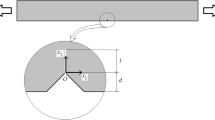Abstract
Breaking down the entire structure of a material implies severing all the bonds between its atoms either by applying work or by heat transfer. Because bond-breaking is indifferent to either means, there is a kind of equivalence between heat energy and strain energy. Based on this equivalence, we assume the existence of a constant maximum storage of energy that includes both the strain energy and the corresponding equivalent heat energy. A temperature-dependent fracture strength model is then developed for ultra-high temperature ceramics (UHTCs). Model predictions for UHTCs, HfB2, TiC and ZrB2, are presented and compared with the experimental results. These predictions are found to be largely consistent with experimental results.
Similar content being viewed by others
References
Wang C.R., Yang J.M., Hoffman W.P.: Thermal stability of refractory carbide/boride composites. Mater. Chem. Phys. 74(3), 272–281 (2002)
Gasch M., Ellerby D., Irby E., Beckman S., Gusman M., Johnson S.: Processing, properties and arc-jet oxidation of hafnium diboride/silicon carbide ultra high temperature ceramics. J. Mater. Sci. 39, 5925–5937 (2004)
Opeka M.M., Talmy I.G., Wuchina E.J., Zaykoski J.A., Causey S.J.: Mechanical, thermal and oxidation properties of refractory hafnium and zirconium compounds. J. Eur. Ceram. Soc. 19(13–14), 2405–2414 (1999)
Bull, J., White, M.J., Kaufman, L.: Ablation resistant zirconium and hafnium ceramics. US Patent 5,750,450 (1998)
Wuchina E., Opeka M., Causey S., Buesking K., Spain J., Cull A., Routbort J., Guitierrez-mora F.: Designing for ultrahigh-temperature applications: The mechanical and thermal properties of HfB2, HfC x HfN x and αHf(N). J. Mater. Sci. 39, 5939–5949 (2004)
Song G.M., Zhou Y., Kang S.J.: Experimental description of thermomechanical properties of carbon fiber-reinforced TiC matrix composites. Mater. Des. 24(8), 639–646 (2003)
Melendez-Martinez J.J., Dominguez-Rodriguez A., Monteverde F., Melandri C., De Portu G.: Characterisation and high temperature mechanical properties of zirconium boride-based materials. J. Eur. Ceram. Soc. 22(14–15), 2543–2549 (2002)
Kinoshiya T., Munekawa S., Tanaka S.I.: Effect of grain boundary segregation on high-temperature strength of hot-pressed silicon carbide. Acta Materialia 45(2), 801–809 (1997)
Kim Y.W., Chun Y.S., Nishimura T., Mitomo M., Lee Y.H.: High-temperature strength of silicon carbide ceramics sintered with rare-earth oxide and aluminum nitride. Acta Materialia 55(2), 727–736 (2007)
Fahrenholtz W.G., Hilmas G.E., Chamberlain A.L., Zimmermann J.W.: Processing and characterization of ZrB2-based ultra-high temperature monolithic and fibrous monolithic ceramics. J. Mater. Sci. 39, 5951–5957 (2004)
Green D.J.: An Introduction to the Mechanical Properties of Ceramics. Cambridge Solid State Science Series, Cambridge (1998)
Volokh K.Y.: Hyperelasticity with softening for modeling materials failure. J. Mech. Phys. Solids 55(10), 2237–2264 (2007)
Knacke O., Kubaschewski O.: Thermochemical Properties of Inorganic Substances, 2nd edn. Springer, Berlin (1991)
Ye, D.L.: Practical Handbook of Thermodynamic Data for Inorganic Compounds, 1st edn, pp. 980–981. Metallurgy Industry Publishing House, Beijing (1981) (in Chinese)
Author information
Authors and Affiliations
Corresponding author
Additional information
The project was supported by the National Natural Science Foundation of China (90505015 and 10702035).
Rights and permissions
About this article
Cite this article
Li, W., Yang, F. & Fang, D. The temperature-dependent fracture strength model for ultra-high temperature ceramics. Acta Mech Sin 26, 235–239 (2010). https://doi.org/10.1007/s10409-009-0326-7
Received:
Revised:
Accepted:
Published:
Issue Date:
DOI: https://doi.org/10.1007/s10409-009-0326-7




